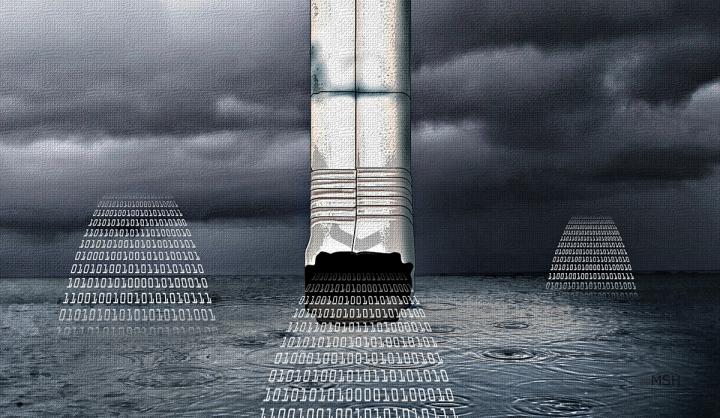Tracking the flow of quantum information

A Yale-led group of researchers has derived a formula for understanding where quantum objects land when they are transmitted. Credit Illustration by Michael S. Helfenbein/Yale University
Now a Yale-led group of researchers has derived a formula for understanding where quantum objects land when they are transmitted. It's a development that offers insight for controlling open quantum systems in a variety of situations.
“The formula we derive turns out to be very useful in operating a quantum computer,” said Victor Albert, first author of a study published in the journal Physical Review X. “Our result says that, in principle, we can engineer 'rain gutters' and 'gates' in a system to manipulate quantum objects, either after they land or during their actual flow.”
In this case, the gutters and gates represent the idea of dissipation, a process that is usually destructive to fragile quantum properties, but that can sometimes be engineered to control and protect those properties.
The principal investigator of the research is Liang Jiang, assistant professor of applied physics and physics at Yale.
It is a fundamental principle of nature that objects will move until they reach a state of minimal energy, or grounding. But in quantum systems, there can be multiple groundings because quantum systems can exist in multiple states at the same time — what is known as superposition.
That's where the gutters and gates come in. Jiang, Albert, and their colleagues used these mechanisms to formulate the probability of quantum objects landing in one spot or the other. The formula also showed there was one situation in which superposition can never be sustained: when a quantum “droplet” in superposition has landed in one “puddle” already, but hasn't yet arrived at the other “puddle.”
“In other words, such a superposition state always loses some of its quantum properties as the 'droplet' flows completely into both puddles,” Albert said. “This is in some ways a negative result, but it is a bit surprising that it always holds.”
Both aspects of the formula will be helpful in building quantum computers, Albert noted. As the research community continues to develop technological platforms capable of supporting such systems, Albert said, it will need to know “what is and isn't possible.”
###
Additional co-authors of the study are Barry Bradlyn of Princeton and Martin Fraas of KU Leuven.
Media Contact
All latest news from the category: Physics and Astronomy
This area deals with the fundamental laws and building blocks of nature and how they interact, the properties and the behavior of matter, and research into space and time and their structures.
innovations-report provides in-depth reports and articles on subjects such as astrophysics, laser technologies, nuclear, quantum, particle and solid-state physics, nanotechnologies, planetary research and findings (Mars, Venus) and developments related to the Hubble Telescope.
Newest articles

A ‘language’ for ML models to predict nanopore properties
A large number of 2D materials like graphene can have nanopores – small holes formed by missing atoms through which foreign substances can pass. The properties of these nanopores dictate many…

Clinically validated, wearable ultrasound patch
… for continuous blood pressure monitoring. A team of researchers at the University of California San Diego has developed a new and improved wearable ultrasound patch for continuous and noninvasive…

A new puzzle piece for string theory research
Dr. Ksenia Fedosova from the Cluster of Excellence Mathematics Münster, along with an international research team, has proven a conjecture in string theory that physicists had proposed regarding certain equations….



